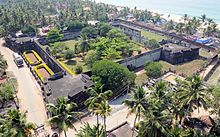


The fort was the East India Company's first permanent post on the Malabar Coast. In November 1693, John Brabourne was sent by the British East India Company (EIC) to Attingal, where he obtained from Rani Ashure a grant of a site for a fort on the sandy spit of Anchuthengu (then known as Anjengo), together with the monopoly of the pepper trade of Attingal. The EIC commenced construction in January 1696.
In June 1696 British pirates in the ketch Josiah under Robert Culliford, destroyed the Bengal Pilot Service's sloop Gingali (or Gingalle) at Anjengo.[1][2]
While construction was ongoing the Dutch lobbied the Rani against the fort's construction, as it would impact adversely on their own trade on the Malabar coast. She ordered Brabourne to stop building but he ignored her orders. The Rani then tried to starve out the British by cutting off supplies; but as they could be supplied from the sea, the land blockade proved ineffectual. She then sent an armed force against Brabourne but he defeated it and a peace was arranged.[3]
The fort was completed in 1699, and a flourishing trade in pepper and cotton cloth speedily grew up. The fort served as the first signaling station for ships arriving from Britain.[4]
The fort is 256 ft (78.0 m) square, with four bastions, each of which mounted eight 18-pounder guns. The walls between the bastions had seven or eight guns. In addition, there was a battery of some twenty 18&24-pounder guns facing the sea. The fort had a garrison of 400 Europeans and 70-80 topasses.[5] Originally Anjengo was second in importance to the EIC only to Bombay Castle.

Of more importance than the attack in 1697 was the incident at Attingal and subsequent siege in April 1721. Brabourne remained in charge of the fort until 1704 when, following the death of his wife, who was buried at the fort, he was succeeded by Simon Cowse. Cowse was in turn replaced by John Kyffin, although he remained at the fort as a free trader. Kyffin exploited his position for self-enrichment and became controversially involved in local politics. Rani Ashure had died some time around 1700 and her successor did not command the same authority (note that Attingal was matriarchal), which contributed to poor relations between her subjects and the British.
By 1717 Kyffin had retired and was replaced by William Gyfford who was if anything even more self serving and divisive than his predecessor and relations with the local people continued to deteriorate.[6]
- ^ Hackman (2001), p. 331.
- ^ Grey (1933), p. 133.
- ^ More (2003), pp.75-6.
- ^ Sathyendran, Nita (26 January 2012). "Hidden 100: In the land of five coconut palms". The Hindu. Retrieved 29 November 2012.
- ^ More (2003), pp.80-1.
- ^ "12englishwoman".
© MMXXIII Rich X Search. We shall prevail. All rights reserved. Rich X Search
